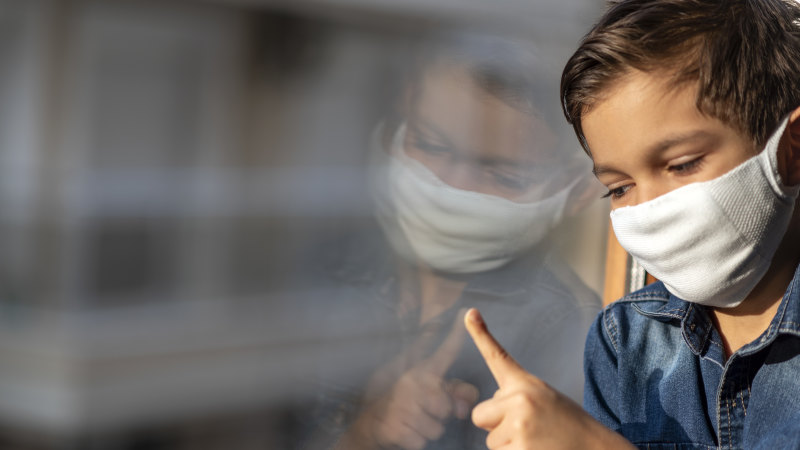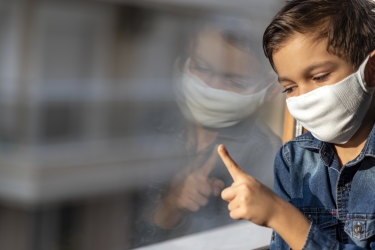For our free coronavirus pandemic coverage, learn more here.
With school returning next week, parents in New South Wales and Victoria are staring down the barrel of giving their children a rapid antigen test (RAT) twice a week for the first month of school. (The NSW government has mandated the measure, the Victorian government has “strongly recommended” it.)
So, the question on every parent or caregiver’s mind is: how can you give a child a RAT – via a nasal swab – so that they’re comfortable and your mornings don’t descend into a swirl of squirming, crying and dirty looks?
“If you look at the swab and it’s parallel to the ground, you’re doing it right,” says Melbourne paediatric respiratory physician Dr Shivanthan Shanthikumar. Credit:iStock
“One thing is getting the technique right and the second thing is trying to make it as child-friendly as possible,” says Dr Shivanthan Shanthikumar, a paediatric respiratory physician at the Royal Children’s Hospital Melbourne.
Firstly, he says, parents or caregivers need to insert the RAT swab into their child’s nose at a horizontal angle. “So your natural tendency, [like] when people pick their noses, is to point the swab vertically to the sky and often the pictures depict that, but actually what’s best is for the swab to go horizontal,” he says. “If you look at the swab and it’s parallel to the ground, you’re doing it right.”
Next, as the Australian Public Health Laboratory Network advises, hold the swab using a pencil grip and, while gently rotating it, insert the tip of it one to two centimetres into a child’s nostril, “or until resistance is met”. (This compares to an adult RAT, which requires an insertion of two to three centimetres into the nostril.) You will be inserting the swab into the nose parallel to the palate. Rotate the swab several times against the nasal wall. Then withdraw the swab and repeat the process in the other nostril.
A catchphrase to remember while inserting the swab is “to go low and slow”, says Dr Eric Levi, an ear, nose, throat, head and neck surgeon at Royal Children’s Hospital Melbourne. “The nose registers movement as pain, so the slower you go, the less painful it will be… Shoving it up really high and really fast can cause a lot of pain,” he says. A fast swab is also much less likely to capture enough of a sample of the mucus and lining of the nose “where the virus antigens are hanging about”, and therefore more likely to elicit a false negative.
What you’re aiming for is the pink skin one to two centimetres inside the nostril, past the dry skin right inside our nostril that has hair on it. “We want the wet part of the nose,” says Levi.
“It should feel uncomfortable, but not painful,” adds Shanthikumar, saying that we should be rotating the swab in each nostril for about 15 seconds. “If you think of picking your nose really deeply, that’s what it should feel like.”
For younger children who might be uncooperative or prone to squirming, Levi offers a handy technique. Seat your child next to you on the sofa, and place your (non-writing) arm around the back of your child’s neck, so that their head is resting back slightly in the crook of your elbow. Holding the swab in your other (writing) hand, place the tip of your little finger on your child’s chin, cheek or upper lip, to stabilise your hand – this will help greatly if they suddenly move – and then proceed to insert the swab into their nose.
“It doesn’t have to be painful or scary,” says Levi. “A gentle, slow and low direction will reduce the pain and help your kids to have it [the swab] again and again and again.”
Aim to be as calm as possible and honest about what the experience will feel like, says Shanthikumar. “If you say ‘It doesn’t hurt’ on the first swab – if we lie to kids – then they’re going to remember [that and] you’re not going to [be able to] do the second or third swabs,” he says. Instead, he advises that parents tell their children it’s going to be a bit uncomfortable, but that they’ll only have to insert the swab into each nostril for 15 seconds.
And keep your delivery light. “There’s no need to catastrophise,” he says. “I’d say something like, ‘It is going to feel a bit funny, but we all pick our nose sometimes, don’t we?’ Something like that.”
Make the most of your health, relationships, fitness and nutrition with our Live Well newsletter. Get it in your inbox every Monday.
Most Viewed in Lifestyle
From our partners
Source: Read Full Article

